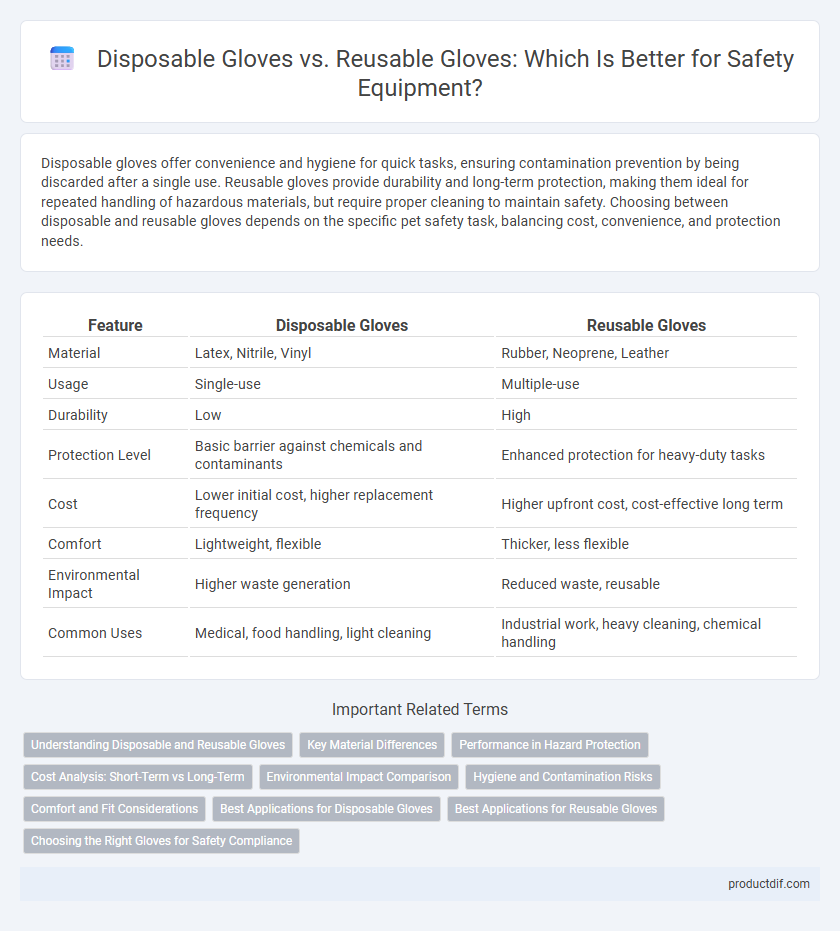Disposable gloves offer convenience and hygiene for quick tasks, ensuring contamination prevention by being discarded after a single use. Reusable gloves provide durability and long-term protection, making them ideal for repeated handling of hazardous materials, but require proper cleaning to maintain safety. Choosing between disposable and reusable gloves depends on the specific pet safety task, balancing cost, convenience, and protection needs.
Table of Comparison
| Feature | Disposable Gloves | Reusable Gloves |
|---|---|---|
| Material | Latex, Nitrile, Vinyl | Rubber, Neoprene, Leather |
| Usage | Single-use | Multiple-use |
| Durability | Low | High |
| Protection Level | Basic barrier against chemicals and contaminants | Enhanced protection for heavy-duty tasks |
| Cost | Lower initial cost, higher replacement frequency | Higher upfront cost, cost-effective long term |
| Comfort | Lightweight, flexible | Thicker, less flexible |
| Environmental Impact | Higher waste generation | Reduced waste, reusable |
| Common Uses | Medical, food handling, light cleaning | Industrial work, heavy cleaning, chemical handling |
Understanding Disposable and Reusable Gloves
Disposable gloves, typically made from nitrile, latex, or vinyl, provide a single-use barrier ideal for preventing cross-contamination in medical and food handling environments. Reusable gloves, often crafted from durable materials like rubber or neoprene, offer long-lasting protection suitable for industrial tasks that involve chemical exposure or heavy-duty cleaning. Understanding the specific application and exposure risks is crucial to selecting the appropriate glove type for optimal safety and hygiene.
Key Material Differences
Disposable gloves are primarily made from latex, nitrile, or vinyl, offering thin, flexible protection ideal for single-use tasks and minimizing cross-contamination risks. Reusable gloves are typically constructed from thicker materials such as rubber, neoprene, or heavy-duty latex, providing enhanced durability and resistance to chemicals, punctures, and wear for prolonged use. The choice between disposable and reusable gloves depends on the specific safety requirements, exposure levels, and the need for dexterity versus long-term protection.
Performance in Hazard Protection
Disposable gloves offer superior contamination control with single-use design preventing cross-contamination, making them ideal for high-risk environments requiring frequent glove changes. Reusable gloves provide enhanced durability and resistance against chemical, puncture, and abrasion hazards, ensuring reliable protection in heavy-duty industrial tasks. Selecting gloves depends on specific hazard exposure, with disposable gloves favored for biological risks and reusable gloves preferred for mechanical and chemical safety performance.
Cost Analysis: Short-Term vs Long-Term
Disposable gloves incur lower initial costs, making them economical for short-term use or tasks requiring frequent glove changes to maintain hygiene. Reusable gloves have a higher upfront investment but offer significant cost savings over time due to their durability and ability to withstand multiple uses and cleanings. Long-term cost analysis favors reusable gloves in environments with consistent use, while disposable gloves are preferable for intermittent or single-use applications to minimize contamination risks.
Environmental Impact Comparison
Disposable gloves generate significant plastic waste and contribute to landfill overflow due to their single-use nature, posing a higher environmental burden. In contrast, reusable gloves made from durable materials reduce waste by allowing multiple uses, decreasing the frequency of disposal and resource consumption. Proper cleaning and maintenance of reusable gloves further extend their lifespan, enhancing their sustainability profile compared to disposable alternatives.
Hygiene and Contamination Risks
Disposable gloves provide superior hygiene by minimizing cross-contamination risks through single-use design, ensuring contaminants are discarded after each task. Reusable gloves, while offering durability, require thorough cleaning and proper storage to prevent bacterial buildup and maintain safety standards. Selecting gloves based on task-specific contamination levels is crucial for optimal infection control in healthcare and industrial environments.
Comfort and Fit Considerations
Disposable gloves offer a lightweight and snug fit, enhancing dexterity and reducing hand fatigue during extended use in medical or laboratory environments. Reusable gloves, often made from thicker materials like nitrile or rubber, provide enhanced durability but may sacrifice some comfort and flexibility, potentially causing sweat buildup and reduced tactile sensitivity. Choosing the right glove depends on balancing protection needs with comfort factors such as fit, breathability, and task duration.
Best Applications for Disposable Gloves
Disposable gloves are ideal for medical, food handling, and laboratory environments where preventing cross-contamination is critical. Their single-use nature ensures maximum hygiene and minimizes the risk of pathogen transfer. Common materials include nitrile, latex, and vinyl, providing options for allergy sensitivity and chemical resistance.
Best Applications for Reusable Gloves
Reusable gloves are ideal for tasks requiring heavy-duty protection and frequent use, such as industrial work, chemical handling, and maintenance jobs. They offer enhanced durability, resistance to abrasion, and cost-effectiveness over time, making them suitable for environments with prolonged exposure to hazards. High-quality materials like nitrile, neoprene, or leather provide superior grip and chemical resistance compared to disposable gloves.
Choosing the Right Gloves for Safety Compliance
Selecting the right gloves for safety compliance requires evaluating the specific hazards, such as chemical exposure, puncture risks, and contamination control. Disposable gloves offer single-use protection ideal for preventing cross-contamination in medical and laboratory settings, while reusable gloves provide durability and cost-efficiency for tasks involving heavy-duty handling or repeated use. Compliance with industry safety standards like OSHA and ANSI ensures the chosen glove type meets required protection levels and maintains workplace safety.
Disposable gloves vs Reusable gloves Infographic

 productdif.com
productdif.com